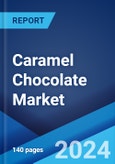Caramel chocolate is a confectionery product made by covering caramel and nougat in milk chocolate. It consists of several ingredients such as nuts, fruits, and white or milk chocolate. Caramel chocolate is available in sweet, nutty, buttery, and bitter flavors, which provides more depth and reduces the overall sweetness of the chocolate. Caramel chocolate is commonly used as a flavoring agent and sauce in desserts like cakes, cupcakes, doughnuts, ice cream, custard, and chocolate candies. It is also added in martinis, pumpkin peas, coffee drinks, truffle ice-creams, and protein bars. In recent years, caramel chocolate has gained popularity as one of the most widely consumed chocolates across the globe.
Caramel Chocolate Market Trends
The market is driven by the increasing consumption of flavored candy and confectionery items, especially among the younger population. In addition, consumers nowadays are willing to pay for premium products that have better quality and flavor, which is fueling the market growth. Besides this, the attractive packaging of caramel chocolate-based desserts and candies are also supplementing the market. Along with this, rapid urbanization and inflating disposable income levels are changing the dietary preferences of consumers, which has escalated the demand for caramel chocolates. Moreover, the rising trend of health consciousness has resulted in the increasing demand for caramel chocolate that contains reduced amounts of fat and artificial sugar. Due to this, key manufacturers are introducing healthier options and smaller portion-size for individuals who focus on portion control and low-calorie intake. Furthermore, the growing demand for organic chocolates made from naturally flavored products is also significantly influencing the demand for caramel chocolate across the globe.Market Segmentation
This report provides an analysis of the key trends in each sub-segment of the global caramel chocolate market report, along with forecasts at the global and regional level from 2025-2033. The report has categorized the market based on distribution channel.Breakup by Distribution Channel
- Supermarkets and hypermarkets
- Convenience stores
- Non-grocery retailers
- Others
Regional Insights
- North America
- Western Europe
- Eastern Europe
- Asia
- Latin America
- Australasia
- Middle East and Africa
Competitive Landscape
The competitive landscape of the market has been examined in the report, with the detailed profiles of some of the key players operative in the industry.Key Questions Answered in This Report
1. What was the size of the global caramel chocolate market in 2024?2. What is the expected growth rate of the global caramel chocolate market during 2025-2033?
3. What are the key factors driving the global caramel chocolate market?
4. What has been the impact of COVID-19 on the global caramel chocolate market?
5. What is the breakup of the global caramel chocolate market based on the distribution channel?
6. What are the major regions in the global caramel chocolate market?
Table of Contents
Methodology

LOADING...
Table Information
| Report Attribute | Details |
|---|---|
| No. of Pages | 149 |
| Published | February 2025 |
| Forecast Period | 2024 - 2033 |
| Estimated Market Value ( USD | $ 6.1 Billion |
| Forecasted Market Value ( USD | $ 9.6 Billion |
| Compound Annual Growth Rate | 5.2% |
| Regions Covered | Global |









